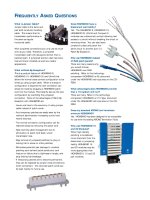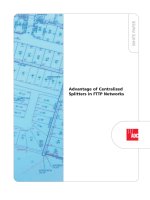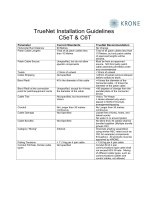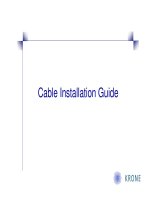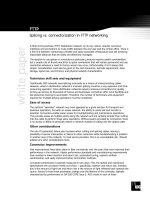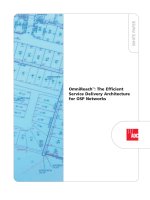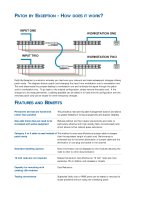KRONE - Guide Book - Patch by Exception - How it works
Bạn đang xem bản rút gọn của tài liệu. Xem và tải ngay bản đầy đủ của tài liệu tại đây (641.94 KB, 1 trang )
PATCH BY EXCEPTION - HOW DOES IT WORK?
Patch-By-Exception is a solution whereby you hard wire your network and make subsequent changes utilising
patch cords. The diagram shows a patch cord changing the input from workstation one to workstation two.
The cord disconnects the jumpers leading to workstation one and re-directs the signal through the patch
cord to workstation two. To go back to the original configuration, simply remove the patch cord. If the
change is to be made permanent, a cabling specialist can be called in to hard wire the configuration and the
removed patch cord can be reused for other temporary changes.
Permanent services are hardwired
rather than patched
Data side frame does not need to be
co-located with active equipment
Category 5 or 6 cable is used instead of
patch cords.
Extensive labelling options
19 inch racks are not required.
Capacity for mounting with
existing LSA modules
Testing convenience
This provides a neat and tidy cable management solution and allows
for greater flexibility of wiring arrangements and superior reliability.
Reduces cabinet and floor space requirements and costs. Is
particularly effective with high density Telco connectorised hubs
which allows further cabinet space reductions.
This method is more cost effective as jumper cable is cheaper
than the equivalent length of patch cord. Performance is
enhanced due to the lower attenuation of jumper cable and the
elimination of one plug and socket in the channel.
More information can be displayed on the modules reducing the
need to refer to other documentation.
Makes this solution cost effective as '19 inch' racks are more
expensive. Fits in shallow wall recesses or closets.
Cost Reduction.
Suspected faulty hub or PABX ports can be tested or rerouted to
locate problems without losing the underlying patch.
FEATURES AND BENEFITS
INPUT ONE
INPUT TWO
WORKSTATION ONE
WORKSTATION TWO
